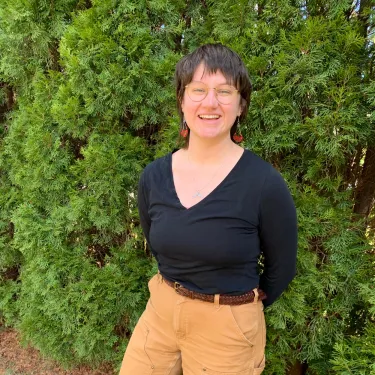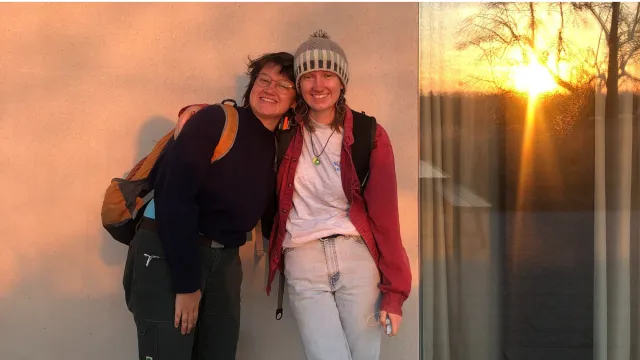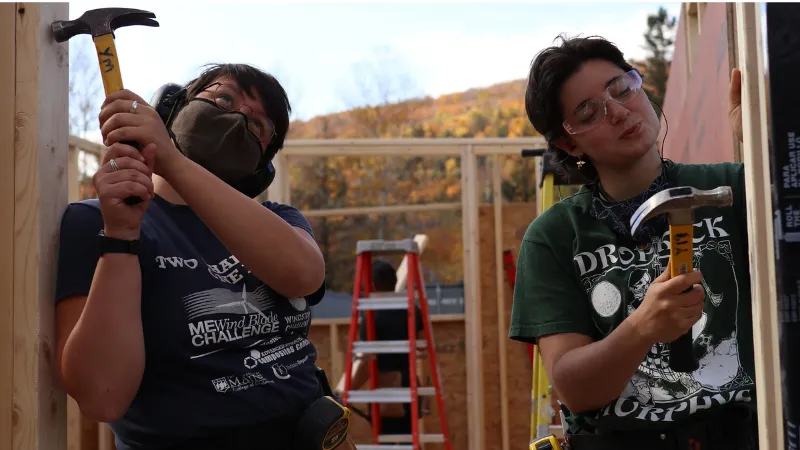Morgan Donovan Jones ’22
Meet the Majors

Other clubs, sports, activities:
Contra dance, Spatial Analysis Lab, Design Thinking Initiative.
Describe your major for someone who has never heard of your field before.
As an engineering B.A. major and landscape studies minor with an environmental climate change concentration, I view my education at Smith as a degree in system thinking and problem solving for community and environmental resilience in the face of climate change.
What’s your all-time favorite Smith memory?
No matter the season, I love taking walks around campus whether I am alone or with friends. Spring is my favorite time at Smith. The hill next to Wright Hall is covered in daffodils and when you round the corner to walk up the hill, you get a nose full of fragrance and color. I know that in another decade I will still remember the feeling of being a Smith student in spring, rounding that corner with the sun on my face, the air thick with daffodils.
I view my education at Smith as a degree in system thinking and problem solving for community and environmental resilience in the face of climate change.
Did you ever have trouble deciding on a major? What, ultimately, helped you decide?
I knew when I came to Smith I wanted to be in the engineering department and, within my first semester at Smith, I declared a B.A. in engineering. I took a class on ecological thinking and human-centered design where I learned about GIS, human behavior and biomimicry, which made me realize that you can design to encourage environmental sustainability and community connectivity and accessibility. I grappled between a B.A. or a B.S. in engineering, but ultimately I knew there was an element of the humanities that I wanted to incorporate in my major.
Could you explain the concentration? Why did you choose the environmental concentration for yours?
While providing structure in the form of the curriculum, mentors and a cohort, the concentration supports the merging of interdisciplinary interests. I joined the concentration because I was interested in city and environmental resilience in response to climate change. I’m interested in how design impacts the relationship between humans with their built environment and the natural world. Through the practical experiences, I got to explore estuaries in overall waders with NOAA, sail in the Hudson River Valley with the Clearwater Sloop, and explore educational outreach related to water resources with the Penobscot Indian Nation.
How do your different studies intersect or help inform each other?
I see all my classes as interconnected. In my engineering classes, I learned concrete mathematical modeling and problem-solving skills that help me understand systems. Through my landscape studies studios and seminars, I explored how the landscape has been transformed by human behaviors and values. My geology and horticultural classes have grounded my understanding of how our natural world might affect housing infrastructure and community. In my design thinking courses, I got to see how design can amplify values and inform behavior. There is so much power in design.

Who is someone that you look up to in your field or someone whose work you admire?
Tony Sohns, my early education homeschooling science teacher, inspired how I engage with learning in my life. He is someone who embodied what it meant to be excited about the natural world and finding the beauty in understanding how ecosystems are interconnected. His passion for inquiry and exploration was infectious, along with his love for bugs and fossils. I experienced the world by roaming through the woods looking for rocks to flip over, splashing around in tide pools along the coast of Maine, and frying grubs for a snack. He was my first peek into what a life dedicated to science and learning could be. These are experiences, memories and a community that I still hold in my heart today.
I also have to mention the amazing professors who I love and admire on campus, including Emily Norton, Gaby Immerman, Reid Bertone-Johnson, Niveen Ismail, R. Koh, Jon Caris, Tracy Tien, and Param Pati. You all have inspired me.
If someone was considering your concentration, what would you tell them?
I came to the concentration looking to bring context and application to the analytical engineering skills I was learning. That’s also how landscape studies became a part of my education at Smith. The concentration is the space where you can talk about interdisciplinary work and the intention and perspective behind the skills you learn. I’m grateful to have had a cohort, who were navigating similar cross-departmental curriculums, and mentors to explore my Smith journey.
Describe a moment from a class that particularly sticks with you.
I remember in Niveen Ismail’s class on thermodynamics, she would make eye contact with me wherever I was in the class and know whether or not I had a question. Even if the rest of the class seemed like they were understanding the topic, it was like she could read my mind. I think it reflects how much Smith professors care for their students and their education.
The concentration is the space where you can talk about interdisciplinary work and the intention and perspective behind the skills you learn.
What’s your “Big Dream” for your future?
I can spend forever thinking about how I want to influence the world or what I want to accomplish. I’m not sure I have one “big dream,” but I know I want to feel connected to people and community and space. I want to design spaces that reflect and build off the environment. In a sense my dream is to continue to pursue learning, building, designing and riding my bike.
What spot on campus will you miss the most? Where was your favorite place for daydreaming or relaxing?
The docks by the boathouse <3 Also the 4th floor of Burton will always hold a special place in my heart.
If you could tell an incoming first-year anything about Smith, what would it be?
Be open to changing your mind and lean into an interdisciplinary education.
What do you think is a “Smithie” thing you do?
I take decompression walks with friends in between the business of life and academics. It would often lead to grabbing cereal from the dining hall, mulling over our classes and panicking about the future.
What do you wish older alums knew about the class of 2022?
This class year is filled with some of the most resilient people I know. All of us have experienced so much uncertainty related to the pandemic, and are still working to find healing and connection through a learning community.
